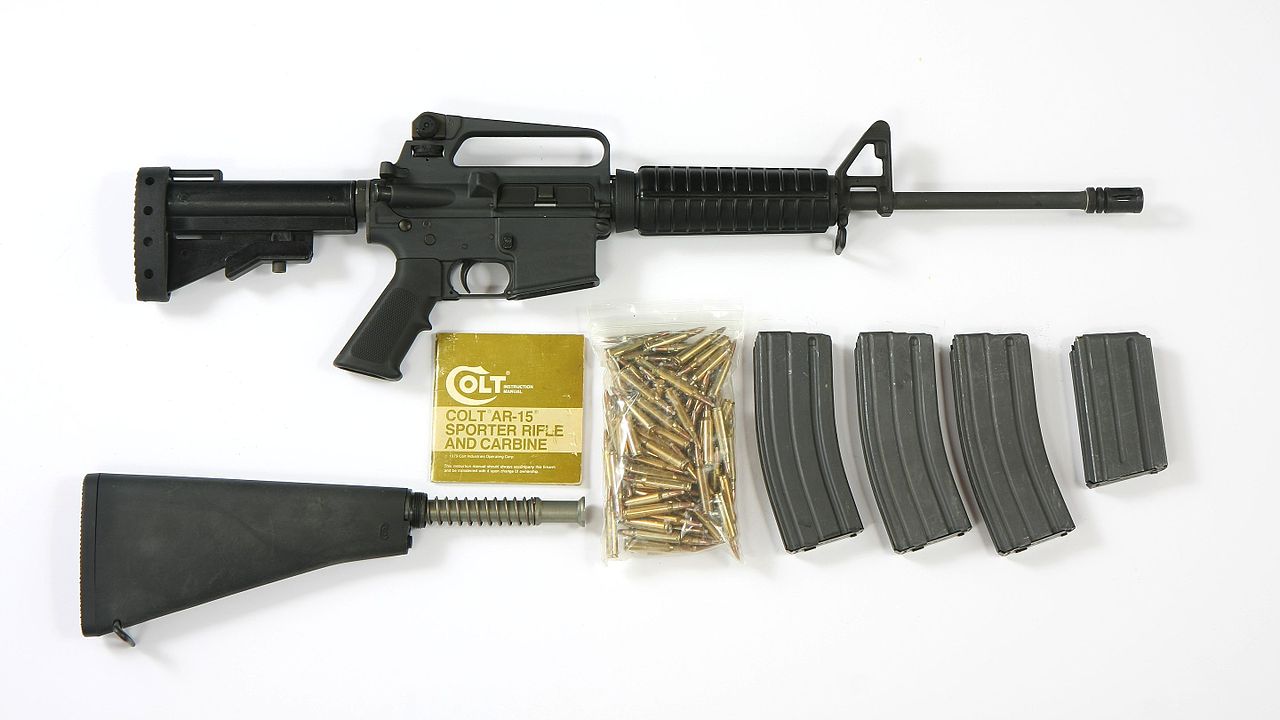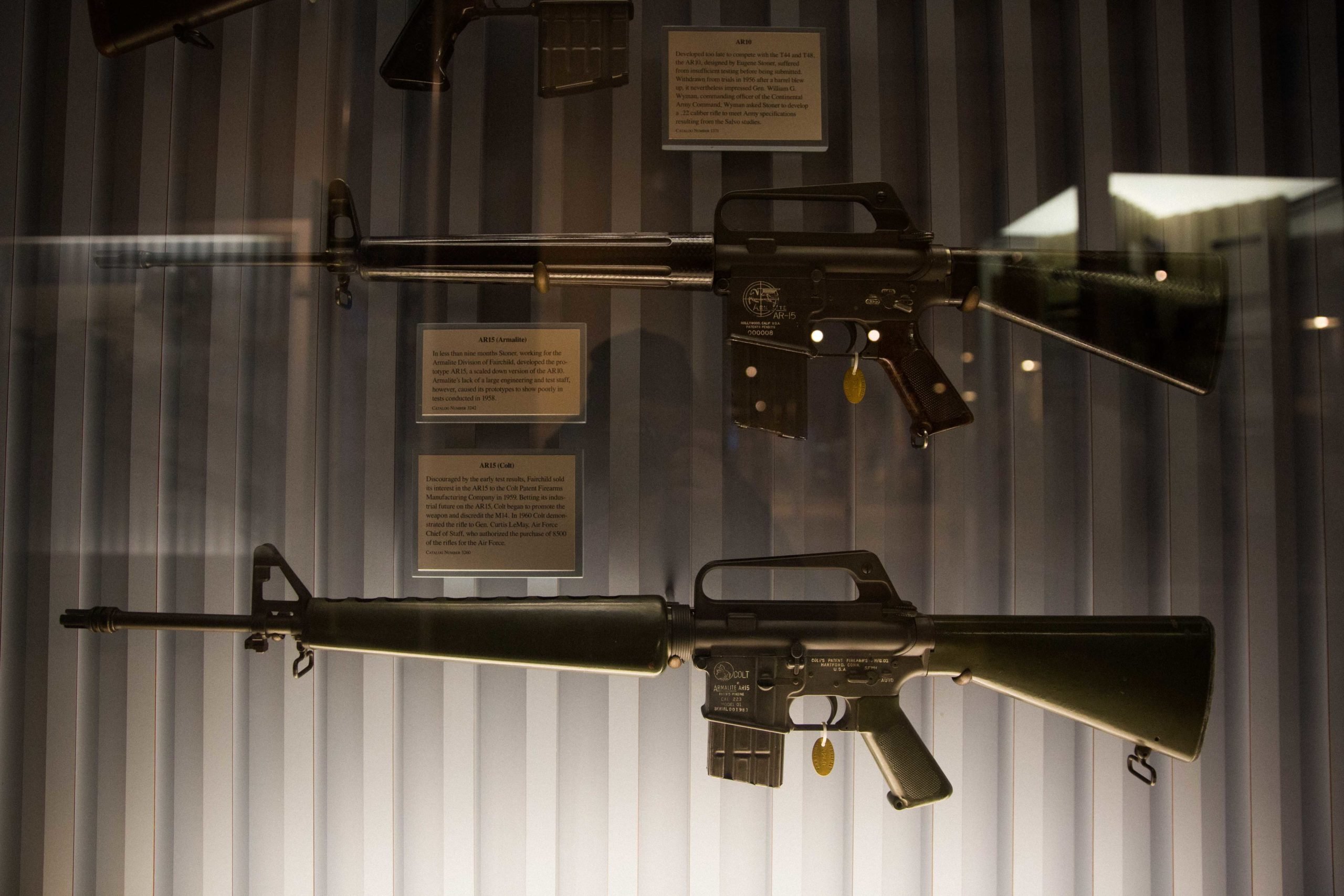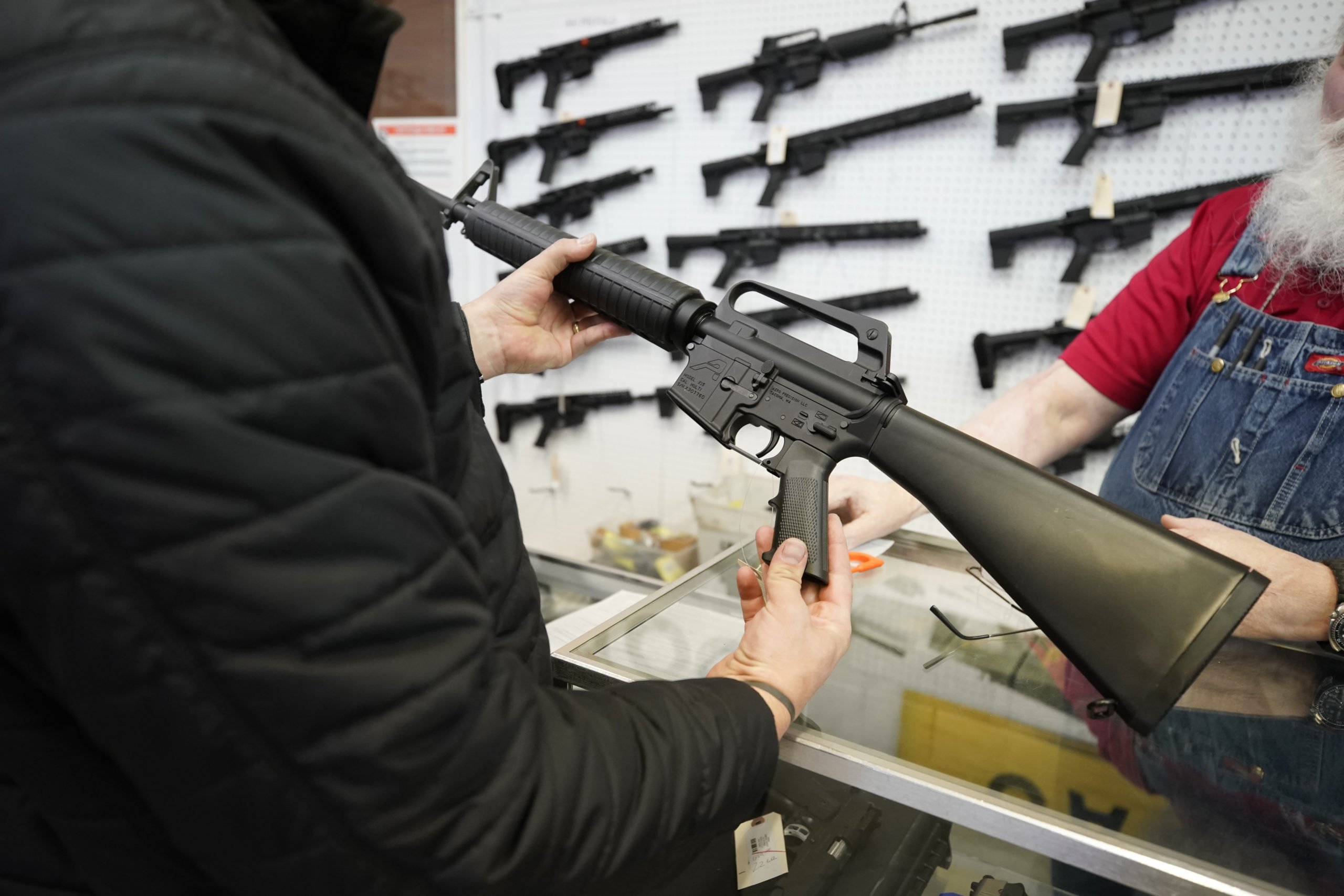In the wake of the mass shootings in Buffalo, New York, and Uvalde, Texas, attention has once again turned to the AR-15-style rifles used by the 18-year-old gunmen. Some lawmakers have proposed raising the age to buy these weapons to 21, while others want to ban them altogether.
But what is the AR-15, exactly? Here we demystify the weapon currently at the center of the gun debate.
Starting with the basics: What is a semiautomatic rifle?
The Bureau of Alcohol, Tobacco, Firearms and Explosives defines a semiautomatic rifle as a weapon designed to be fired from the shoulder that “utilizes a portion of the energy of a firing cartridge to extract the fired cartridge case and chamber the next round,” and shoots a single bullet with each pull of the trigger.
Semiautomatic rifles take many forms — technically and visually. They are made of wood, metals, and polymers. They fire rounds of varying calibers. And they are designed for many different purposes.
The M1 Garand, the U.S. service rifle during World War II, is a semiautomatic rifle. It is mostly made of wood, accepts eight-round clips of .30-06 ammunition, and fires 40 to 50 rounds per minute.

The Ruger 10/22, among the most popular rifles ever made, is also semiautomatic. It’s made from polymers or wood, fires .22-caliber rounds (popular for target shooting and hunting small game), and comes with a magazine that accepts 10 rounds.

Those don’t look like assault weapons…
That’s correct. Semiautomatic is a way to describe a rifle’s basic functionality, how you might say a car has an automatic or manual transmission.
The “assault weapon” or “assault rifle” distinction derives more from a semiautomatic rifle’s features, both cosmetic and functional. The ATF defines a “semiautomatic assault weapon” as a semiautomatic rifle that uses a detachable magazine and has any two of the following features:
- A folding or telescoping stock, which is when the back part of the gun folds or detaches and reduces the length of the rifle.
- A pistol grip that protrudes vertically, similar to a handgun.
- A mount underneath the barrel for attaching a bayonet or a knife.
- A flash suppressor, which is a device that attaches to the muzzle and reduces the intensity of the flash generated when the gun fires (or a threaded barrel designed to accommodate a flash suppressor).
- A grenade launcher.
So what is the AR-15?
The AR-15 was designed in the mid-1950s by the California-based small arms manufacturer ArmaLite. (“AR” stands for “ArmaLite Rifle,” not “assault rifle,” as is often assumed.) The original AR-15 had a “select fire” capability, giving users the option to shoot in semiautomatic mode; fully automatic mode, which continues firing until the trigger is released; or burst mode, which ejects three bullets per trigger pull.
It was intended for the U.S. military, which was in need of a lightweight rifle with expanded ammunition capacity. But after it failed to attract buyers, ArmaLite sold its AR-15 design to Colt, one of America’s oldest gunmakers. Colt made some design tweaks to the AR-15, and in 1963 it marketed the rifle (successfully) to the military as the M16. It developed a semiautomatic version of the AR-15 for the civilian market at around the same time.

And these are the same guns that people are buying today?
Not exactly. This is where much of the misinformation about the AR-15 stems from.
Colt’s patent on the AR-15 expired in 1977, freeing other manufacturers to make their own versions of the rifle. The term “AR-15” is actually trademarked by Colt, which markets the “Colt AR-15.” All other semiautomatic rifles are more accurately referred to as “AR-style” or “AR-15-style” rifles.
So there are many different types of AR-15-style rifles?
Yes. There are hundreds of companies making their own AR-style rifles. And that’s why it’s helpful to think of the AR-15 not as a single type of rifle, but as a weapons platform that is highly modifiable and configurable. Think of the AR-15 not as a model of car, but a class. It’s not a Jeep Wrangler specifically, but an SUV, which can be made by dozens of manufacturers and come in all shapes and sizes.
For example, while the original AR-15 was chambered in .223/5.56mm NATO, modern iterations of the gun are available in dozens of different calibers.
How many are in circulation?
For decades, ARs were on the fringes of the gun industry, with fewer than 100,000 produced each year. In 2004, when a 10-year ban on the rifles was lifted (more on that below), production ramped up, more than doubling between 2011 and 2012. Now, anywhere from 1.5 to 2.5 million are produced annually. The industry bet big on the weapons to offset years of declining handgun sales, and its advertising became increasingly militaristic. Gun companies pursued product placement in first-person shooter video games and ran advertisements conflating semiautomatic rifles with masculinity. The aggressive marketing of the AR-style Remington rifle used in the Sandy Hook massacre was at the heart of a lawsuit brought by victims’ families, which was eventually settled for $73 million earlier this year.
Amid a growing backlash, the industry rebranded the guns as “modern sporting rifles.” More than 24 million of them have been produced in the last three decades, according to a recent report by the National Shooting Sports Foundation, the gun industry’s trade group. That accounts for only around six percent of the country’s estimated 393 million civilian firearms, but the gun lobby still refers to AR-style rifles as “commonly-owned firearms.” That’s a calculated political decision: The Supreme Court has ruled that guns that are “in common use” are constitutionally protected.
Why do AR-style rifles appeal to gun owners?
They’re modular, with components that can be swapped out, which is fun for gun enthusiasts. Modifying semiautomatic rifles is an industry unto itself, and a lucrative one. You can add magnifying scopes or red-dot sights that help you home in on a target, or switch out your trigger or pistol grip to better suit your tastes. “By the time you’re done with all your AR-15 mods and AR-15 upgrades, you will have spent a lot of money,” a former Marine wrote on a firearms site last year.
Proponents of AR-style rifles argue that they’re ideal for hunting certain types of animals, including goats, wild pigs, elk, and coyotes. AR-15-style rifles are easily disassembled, and their portability is a benefit on long hunts. They can kill multiple animals quickly, and they’re accurate at long distances. And AR-style rifles can have less recoil than traditional hunting rifles.
But others say that these weapons are not widely used for hunting, and are more commonly used as toys for “wannabe weekend warriors,” as one hunter and military veteran put it. Some gun owners freely admit that: Shortly after the Uvalde school shooting, an Alabama gun owner wrote on Reddit, “Let’s cut the bullshit. We aren’t buying AR-15’s to kill a white tail buck and put food on the table. We are buying them for hobby, target shooting, and showing them off to our friends. It’s ‘fun.’”
Gun rights activists also say AR-15s are used for home self-defense. In 2017, a commentator with the now-defunct NRA-TV put it bluntly: “I personally think it is a mistake for people to say it’s used for hunting, or it’s used for target shooting. I have my AR-15 to kill people.”

How often are they used in crimes?
Rarely. According to FBI data, nearly two-thirds of homicides are perpetrated with handguns.
So why do people want to ban them?
Because they’ve been used in some of the deadliest mass shootings in history, including Sandy Hook in 2012; San Bernardino in 2015; Pulse in 2016; Las Vegas and Sutherland Springs in 2017; El Paso in 2019; Boulder in 2021; and now Buffalo and Uvalde. Most mass shootings are perpetrated with handguns, but rifles are more likely to be deadly.
That’s because rifle rounds travel at a higher velocity than handgun rounds. A standard rifle round contains more gunpowder than a 9mm handgun round, giving it more velocity, so it strikes the body with more force, Cynthia Bir, a biomedical engineer at Wayne State University, told 60 Minutes in May. Bir demonstrated the difference by firing both types of bullets through a block of gelatin as a stand-in for human flesh. The handgun round passed through the gelatin in a straight line, while the rifle round created a cavity several inches wide.
The shockwave generated by a rifle round kills soft tissue far from the entry point, and trauma physicians say exit wounds can be as big as an orange. “There’s going to be a lot more damage to the tissues, both bones, organs, whatever gets kind of even near this bullet path,” Bir told 60 Minutes. “The bones aren’t going to just break, they’re going to shatter.” The longer the barrel, the higher the velocity of the bullet, making it even deadlier.
Critics argue that the guns are weapons of war that were designed for the battlefield and have no business in the civilian market. “They are the Formula One cars of guns, designed to kill as many people as quickly and efficiently as possible,” Joe Plenzler, a Marine combat veteran, told The New York Times in 2018. The gun industry rejects that characterization, pointing to the fact that they’re not fully automatic. But combat troops often fire their M4s and M16s in semiautomatic mode, as opposed to fully automatic or burst mode, because semiautomatic fire is easier to control and therefore more accurate.
Have AR-style rifles been banned before?
Sort of. In 1994, Congress enacted a ban on “assault weapons,” defined as semiautomatic firearms that accept detachable magazines and have two of the features listed above. The legislation also banned magazines that held more than 10 bullets. The ban was first proposed in 1989, when a teacher and 34 children were struck by semiautomatic rifle fire, five of them fatally, at Cleveland Elementary School in Stockton, California.
Gun rights activists and gun control advocates alike criticized the criteria, calling the banned features “cosmetic” because the rifle could still operate without most of them. That created a workaround: Firearms manufacturers could make minor modifications that allowed them to circumvent the ban. “The gunmakers simply made the exact same gun with the same lethality, but without the butt stock and the bayonet lug,” UCLA law professor Adam Winkler recently told NPR.
There was another loophole: Guns made before the law took effect were grandfathered in, and were sold on the secondary market throughout the ban.
The law had a sunset provision that required Congress to reauthorize it in 10 years. In 2004, the GOP-led Congress allowed it to lapse.
Was the assault weapons ban effective at reducing mass shootings?
Yes, according to the few studies that are out there. In 2019, Stanford law professor John Donohue analyzed public mass shootings in which six or more people were killed over a 35-year-period and found a slight drop in incidents during the decade-long ban compared to the decade before. Notably, in the decade after the ban expired, fatalities in high-casualty public mass shootings soared by 347 percent.
Do any states ban AR-15s?
Sort of. Seven states — including California, New York, and Massachusetts — and Washington, D.C., ban the sale of assault weapons, according to Giffords Law Center.
These laws generally focus on limiting the sale of specific rifle models or semiautomatic rifles with a number of features, such as pistol grips or folding stocks. In some cases, states require owners of guns purchased before their bans to register them with authorities, but not in all.
But the laws haven’t kept pace with gunmakers, who continue to alter their weapons so that they lack a prohibited feature while still retaining the same level of lethality. (In the case of the Buffalo gunman, he bought a so-called New York compliant AR-style rifle that he illegally modified.)

California’s assault weapons ban, enacted after the Cleveland Elementary School shooting in 1989, survived multiple court challenges until last year, when it was overturned by a federal district judge. If the ruling stands, it could signal trouble for other states’ policies. “As mass shootings become more of a political issue, the [Supreme] court is going to take options away from lawmakers on the basis of the Second Amendment,” UCLA law professor Adam Winkler told The Hill in May.
Is another federal assault weapons ban likely?
No, not with a 50-50 Senate and a filibuster that at least two Democratic senators firmly oppose eliminating. On June 2, House Speaker Nancy Pelosi said the House will consider an assault weapons ban, but if it passes, it’s likely to stall in the Senate.
President Biden campaigned on a permanent renewal of the assault weapons ban, but he can’t implement one without Congress. Even former President Donald Trump reportedly wanted to ban semiautomatic rifles, or at least raise the age to buy them, until the National Rifle Association talked him out of it. In 2019, The Trace’s Champe Barton imagined what an assault weapons ban and subsequent government buyback might look like, and found that it would cost anywhere from $700 million to $16 billion.
Other countries have regulated semiautomatic rifles in response to massacres, most recently New Zealand, which banned them less than a month after the 2019 Christchurch mosque massacre. Australia banned the weapons after a 1996 rampage committed with the Colt AR-15 and has had only one mass shooting since.
Correction: An earlier version of this story mischaracterized a passage from a previous Trace article comparing different types of rifle rounds. The excerpt has been removed.

